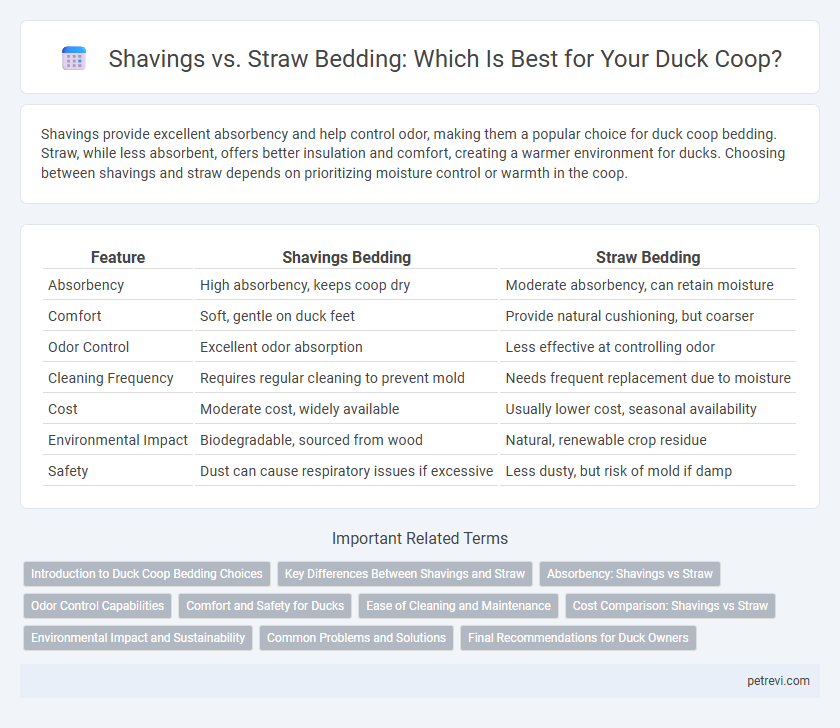Shavings provide excellent absorbency and help control odor, making them a popular choice for duck coop bedding. Straw, while less absorbent, offers better insulation and comfort, creating a warmer environment for ducks. Choosing between shavings and straw depends on prioritizing moisture control or warmth in the coop.
Table of Comparison
| Feature | Shavings Bedding | Straw Bedding |
|---|---|---|
| Absorbency | High absorbency, keeps coop dry | Moderate absorbency, can retain moisture |
| Comfort | Soft, gentle on duck feet | Provide natural cushioning, but coarser |
| Odor Control | Excellent odor absorption | Less effective at controlling odor |
| Cleaning Frequency | Requires regular cleaning to prevent mold | Needs frequent replacement due to moisture |
| Cost | Moderate cost, widely available | Usually lower cost, seasonal availability |
| Environmental Impact | Biodegradable, sourced from wood | Natural, renewable crop residue |
| Safety | Dust can cause respiratory issues if excessive | Less dusty, but risk of mold if damp |
Introduction to Duck Coop Bedding Choices
Shavings and straw are popular bedding options in duck coops, each offering distinct benefits for hygiene and comfort. Pine shavings provide excellent absorbency and odor control, reducing moisture that can lead to harmful bacteria growth. Straw offers natural insulation and is biodegradable, making it a sustainable choice that keeps ducks warm in cooler climates.
Key Differences Between Shavings and Straw
Wood shavings provide superior moisture absorption and odor control compared to straw, making them ideal for maintaining a dry and clean duck coop environment. Straw bedding offers better insulation and cushioning, which can enhance comfort and warmth for ducks during colder months. While shavings reduce the risk of mold and ammonia buildup, straw is often more affordable and renewable, influencing the choice based on climate and budget considerations.
Absorbency: Shavings vs Straw
Wood shavings provide superior absorbency compared to straw bedding, effectively trapping moisture and reducing wetness in duck coops. Straw tends to retain more moisture on its surface, which can increase humidity and discomfort for ducks. Choosing highly absorbent shavings promotes a drier, cleaner environment, minimizing the risk of bacterial growth and respiratory issues.
Odor Control Capabilities
Shavings bedding excels in odor control for duck coops due to its superior absorption of moisture and ammonia, reducing the buildup of unpleasant smells. Straw bedding tends to retain moisture longer, creating a breeding ground for bacteria that increases odor levels. Choosing kiln-dried softwood shavings can optimize air quality and maintain a fresher environment in the duck coop.
Comfort and Safety for Ducks
Shavings provide soft, absorbent bedding that helps keep duck coops dry, reducing the risk of bacterial growth and foot infections, enhancing overall duck comfort and safety. Straw bedding offers good insulation but holds moisture longer, potentially creating damp conditions that can promote mold and respiratory issues in ducks. Prioritizing moisture control and cleanliness in either bedding type is essential to maintain a healthy and comfortable environment for ducks.
Ease of Cleaning and Maintenance
Shavings bedding offers superior ease of cleaning due to its finer texture, which absorbs moisture effectively and reduces odor buildup in duck coops. Straw bedding tends to retain moisture longer, making it heavier and more challenging to replace regularly. Regular maintenance with shavings requires less labor and helps maintain a healthier environment for ducks by minimizing bacterial growth.
Cost Comparison: Shavings vs Straw
Wood shavings typically cost more upfront than straw but offer greater absorbency and longer-lasting freshness in duck coops, reducing frequency of bedding replacement and overall expenses. Straw, while cheaper initially, tends to decompose faster and can harbor moisture, leading to increased maintenance and potential health issues for ducks. Evaluating the total cost involves balancing the initial purchase price with durability and hygienic benefits crucial for duck health.
Environmental Impact and Sustainability
Shavings bedding for duck coops typically originates from wood byproducts, contributing to resource efficiency but may involve chemical treatments that affect biodegradability. Straw bedding is a renewable agricultural residue that decomposes naturally, enriching soil quality and supporting sustainable waste management practices. Choosing straw over shavings reduces environmental footprint by promoting circular agriculture and minimizing chemical residue in duck habitats.
Common Problems and Solutions
Shavings bedding in duck coops often leads to moisture retention, causing unpleasant odors and increased risk of bacterial growth, while straw tends to mat down and become damp quickly, creating unsanitary conditions. To mitigate these issues, regular cleaning and ensuring proper ventilation are critical for both bedding types to maintain dryness and reduce ammonia buildup. Using kiln-dried pine shavings can minimize moisture absorption, and replacing straw frequently prevents mold and keeps ducks healthy.
Final Recommendations for Duck Owners
Shavings provide excellent absorbency and odor control in duck coop bedding, making them ideal for maintaining a dry environment. Straw offers natural insulation and comfort but may retain moisture, increasing the risk of bacterial growth. For optimal duck health and hygiene, using kiln-dried pine shavings with regular cleaning is recommended over straw bedding.
Shavings vs Straw bedding for Duck coop Infographic

 petrevi.com
petrevi.com